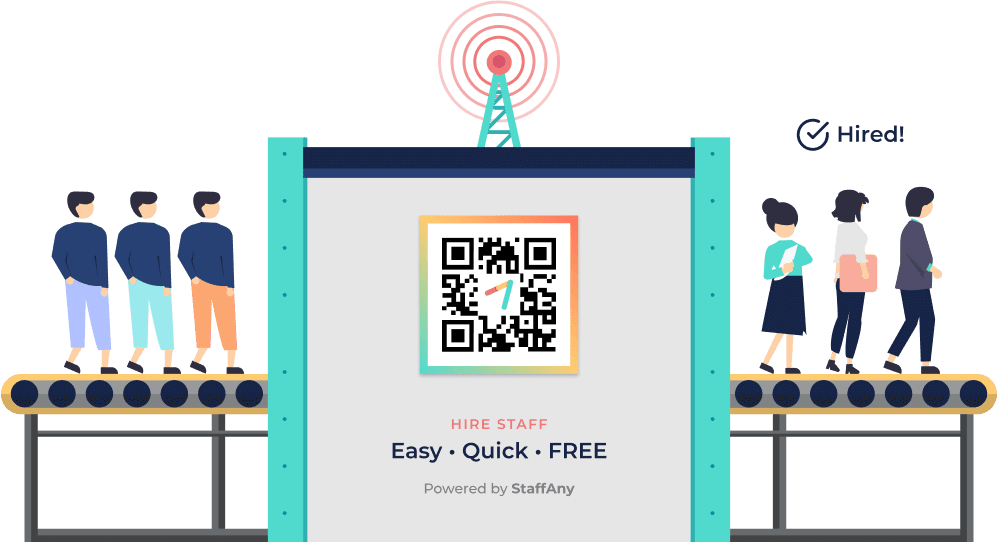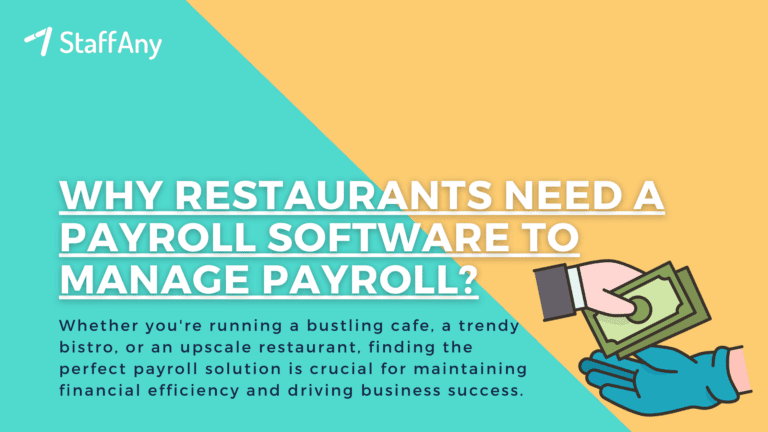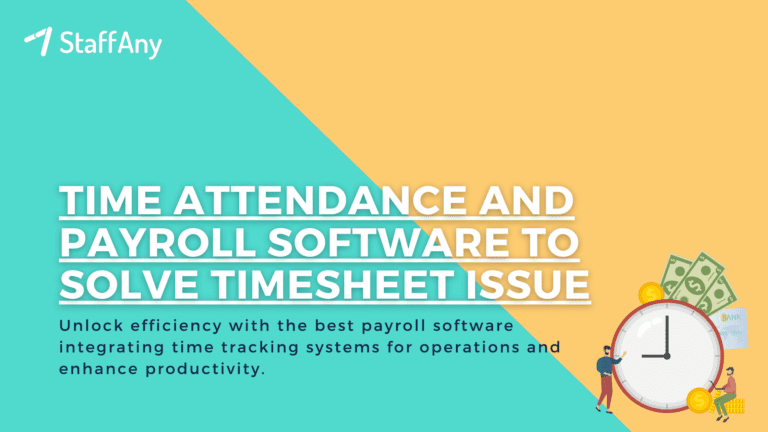In today’s dynamic business landscape, the challenge of high staff turnover looms as a formidable obstacle, casting its shadow across organisations spanning diverse industries. High staff turnover, characterised by the frequent departure of employees and the induction of recruits, has emerged as a multifaceted issue with far-reaching ramifications.
This article will explore the key causes of high staff turnover and provide effective strategies to prevent it. By understanding these factors and implementing proactive measures, businesses can foster a more stable and committed workforce. Let’s get started!
What is a High Staff Turnover?

High staff turnover is a significant workforce challenge that businesses face. It represents the rate at which employees leave a company and are replaced by new hires. This phenomenon can profoundly impact an organisation’s operations, team dynamics, and overall success. When the turnover rate is high, it indicates that employees are departing the company faster than new employees are being recruited. This can lead to a continuous cycle of hiring, training, and onboarding, which can be resource-intensive and disruptive.
Read more: How to Measure Employee Turnover Rate
What Causes High Staff Turnover?
High staff turnover emerges as a complex tapestry woven from diverse threads in the intricate web of organisational dynamics. Each thread represents a distinct factor contributing to the phenomenon, resulting in a continuous cycle of employee departures. Acknowledging these elements is the first step towards formulating effective prevention strategies. Here, we unravel the ten pivotal causes behind high staff turnover:
1. Lack of Growth Opportunities
In the modern workplace, employees are not merely seeking jobs but pursuing careers. When organisations fail to provide avenues for professional advancement, employees feel stagnant and unfulfilled. This absence of growth prospects can lead to diminished motivation and, eventually, a decision to explore opportunities elsewhere. Offering training programs, mentorship, and a clear career trajectory can address this cause and cultivate a sense of long-term commitment.
2. Inadequate Compensation
Compensation is a tangible reflection of an employee’s value to an organisation. When an individual’s efforts are not rewarded fairly, job satisfaction takes a hit. In such scenarios, employees may be inclined to explore positions that offer better financial incentives, ultimately contributing to the turnover rate. Ensuring competitive and equitable compensation packages can be a proactive measure to retain talent and diminish turnover.
3. Poor Management
Effective leadership plays a pivotal role in shaping a positive work environment. Poor management, characterised by a lack of communication, insufficient guidance, and an inability to foster collaboration, can create an atmosphere of frustration and disengagement. Employees who feel undervalued or unsupported by their supervisors are likelier to consider alternative opportunities where their contributions are recognised and encouraged.
4. Unpleasant Work Culture
The culture within an organisation sets the tone for interactions and engagement. A negative or toxic work culture, marked by a lack of respect, discrimination, or a disregard for work-life balance, can erode employees’ morale and sense of belonging. In search of a more inclusive and supportive environment, individuals may leave, seeking workplaces prioritising their well-being and personal growth.
5. Limited Work-Life Balance
Pursuing professional success should not come at the expense of personal well-being. Organisations that demand excessive working hours and neglect the importance of work-life balance can contribute to employee burnout and stress. Individuals seeking harmony between their professional and personal lives will likely gravitate towards employers who understand and support this crucial equilibrium.
Read more: 10 Employee Retention Programs to Retain Your Top Talents
6. Insufficient Recognition
Human nature seeks validation and appreciation for accomplishments. The lack of recognition for contributions and achievements can lead to feeling undervalued in the workplace. Employees who invest time and effort in their roles but receive minimal acknowledgement might consider transitioning to environments where their hard work is celebrated and their dedication is noticed.
7. Lack of Clear Communication
Effective communication serves as the linchpin of a harmonious workplace. When roles, responsibilities, and expectations are clear due to inadequate communication, employees can experience clarity and satisfaction. Such ambiguity can erode engagement and commitment, prompting employees to seek clarity and direction elsewhere.
8. Inadequate Training and Onboarding
Proper training and onboarding are essential for setting employees up for success. With comprehensive training, individuals may feel equipped to perform their roles competently. This deficiency can lead to frustration and diminished job satisfaction, making employees more susceptible to considering opportunities that offer better preparation and support.
9. Job Dissatisfaction
Employees invest a significant portion of their lives in their jobs. When the tasks and responsibilities of a role become mundane, unchallenging, or misaligned with an individual’s skills and passions, job dissatisfaction can take root. In such cases, exploring alternative positions that align more closely with their aspirations becomes an enticing option for seeking greater professional fulfilment.
10. Absence of Employee Involvement
Employees who feel like active contributors to their workplace are more likely to feel engaged and valued. Conversely, an environment that suppresses employee input and decision-making can lead to feelings of insignificance and detachment. The absence of opportunities to voice opinions and shape the organisation’s direction can drive employees to explore environments that encourage their active involvement.
Read more: 12 Employee Engagement Activities to Keep Your Staff Happy and Motivated
What are the Effects of Employee Turnover in an Organization or Business?
High turnover, or a frequent and rapid departure of employees from an organization, can have several negative effects on both the short-term and long-term success of a business. Some of the key consequences of high turnover include:
1. Increased Recruitment and Training Costs
Constantly replacing departing employees requires significant resources for recruiting, onboarding, and training new staff. The associated costs can strain the organization’s budget and impact its financial stability.
2. Disruption in Workflow and Productivity
The departure of experienced employees often leads to disruptions in workflow and a temporary decline in productivity. New hires may take time to get up to speed, affecting the overall efficiency of the team or department.
3. Negative Impact on Morale
Frequent turnover can create a sense of instability and insecurity among remaining employees. Morale may suffer as the team witnesses colleagues leaving regularly, leading to decreased job satisfaction and potentially contributing to a toxic work culture.
4. Diminished Team Cohesion
A stable team with established relationships often performs more cohesively. High turnover disrupts team dynamics and can hinder collaboration. Continuously introducing new team members may lead to a lack of trust and a breakdown in communication.
5. Reduced Customer Satisfaction
In industries where customer-facing roles are prevalent, high turnover can negatively impact customer satisfaction. Customers may become frustrated with dealing with new representatives, leading to a decline in service quality and customer loyalty.
6. Difficulty in Succession Planning
Continuous turnover makes it challenging for organizations to implement effective succession planning. The absence of a stable talent pool can hinder the development of future leaders within the company.
7. Increased Workload on Remaining Staff
When employees leave, the workload often falls on the shoulders of those who remain. This can lead to burnout, stress, and decreased job satisfaction among existing staff, contributing to a cycle of further turnover.
8. Impact on Employer Brand
High turnover can damage an organization’s reputation as an employer. Potential candidates may be hesitant to join a company with a history of frequent turnover, making it more challenging to attract top talent.
9. Difficulty in Building a Positive Organizational Culture
High turnover makes it difficult to establish and maintain a positive organizational culture. A stable and committed workforce is crucial for fostering a sense of belonging and shared values within the organization.
To mitigate the negative effects of high turnover, organizations should focus on employee retention strategies, such as improving workplace culture, offering competitive benefits, providing opportunities for professional development, and addressing issues that may contribute to dissatisfaction among employees.
Read more: 10 Effective Strategies for Managing Diversity in the Workplace
Effective Ways to Address High Staff Turnover
Navigating the challenges of high employee turnover necessitates a comprehensive and multifaceted approach. Acknowledging underlying factors needs improvement; proactive strategies are essential to foster employee engagement and retention. Let’s delve into ten proven methods to reduce employee turnover effectively:
1. Create Growth Paths
Investing in employees’ professional development is akin to sowing seeds of commitment. Implement robust training initiatives that encompass skill enhancement and career progression. Clearly defined pathways for advancement empower employees with a sense of purpose and longevity within the organisation. When they can envisage their future growth, the allure of external opportunities diminishes significantly.
2. Competitive Compensation
The correlation between equitable compensation and job satisfaction is undeniable. Regularly evaluating salary structures vis-à-vis industry benchmarks ensures that employees are rewarded fairly for their contributions. Recognising employees’ worth can help retain talent and form a sturdy bulwark against the pull of alternative job offers.
3. Enhance Management Skills
The managerial echelons are the fulcrum of organisational dynamics. Developing leadership competencies via dedicated training programs ensures that managers possess the understanding to create a nurturing environment. Effective communication, empathy, and the capacity to guide and inspire teams reduce attrition by cultivating a sense of belonging.
Read more: 8 Staff Schedule Management Tips for Business Owners
4. Cultivate a Positive Culture
The contours of workplace culture shape the experiences of employees. Encouraging activities that foster inclusivity, mutual respect, and collaboration nurture an environment that employees yearn to be part of. Celebrate diversity, emphasise teamwork, and build camaraderie to cultivate a culture that becomes a bulwark against attrition.
5. Promote Work-Life Balance
Recognising the modern employee’s need for equilibrium between work and personal life is crucial. Introduce flexible working arrangements, champion remote work options, and establish policies acknowledging and respecting personal commitments. When employees prioritise their holistic well-being, their attachment to the organisation strengthens.
6. Regular Recognition
Human nature thrives on acknowledgement and praise. Institutionalising regular recognition programs, both formal and informal, for accomplishments of all scales cultivates an atmosphere of appreciation. Celebrating employees’ achievements tangibly showcases their value, fostering a sense of loyalty and pride in their contributions.
7. Transparent Communication
Open lines of communication function as bridges between leadership and employees. Transparency regarding company goals, shifts, and progress builds trust and understanding. Uncertainty evaporates in the face of information, fostering engagement and establishing a connection that weathers the turbulence of attrition.
8. Comprehensive Training
Investing in comprehensive onboarding and continuous training programs signifies an investment in employee growth. Proficiency and confidence derived from thorough preparation translate into job satisfaction. When employees feel well-equipped and competent, the urge to explore greener pastures subsides.
Read more: 10 Best Training Plans for Restaurant Staff
9. Job Design and Enrichment
Crafting roles that align with employees’ competencies and aspirations is pivotal. Regularly assess and enhance job responsibilities to sustain engagement. Roles that challenge, captivate, and offer avenues for skill application become sources of fulfilment, rendering thoughts of departure less compelling.
10. Employee Involvement
Empowering employees with a voice is synonymous with nurturing loyalty. Establish platforms for input, feedback, and active participation in decision-making. When employees feel their opinions matter and influence organisational trajectories, their commitment deepens, fortified by a sense of co-ownership.
Read more: The Importance of Employee Engagement for Business
Find the Right Candidate with Applicant Tracking System

Do you now understand causes of high employee turnover and looking to find the right talent effectively for your establishment? Try to use Applicant Tracking Software like StaffAny. This system makes it easy for you to manage job posting and find the right candidate in a timely manner.
Here are some benefits of ATS Software you will gain:
1. Quickly Share Job Openings with QR Code & URL
You can effortlessly connect with specific job seekers across various platforms using StaffAny’s auto-generated QR code and URL. By utilizing multiple job boards feature, you can identify the best talent for your business.
This effective recruiting software will assist business owners in enhancing their operations with a new hiring strategy.
2. Customize Your Job Application Form
Customize your application form with screening questions to obtain the relevant information from job seekers.
Boost your job postings by incorporating detailed job descriptions, enabling potential candidates to grasp the requirements of the position. Furthermore, you can elevate your hiring process by leveraging StaffAny’s applicant tracking system.
3. Streamline Your Hiring Process with StaffAny
As a business owner, you can effortlessly review and manage candidates, along with tracking job applications, through our all-in-one applicant tracking system. All qualified candidates from your posted job listings will be sorted automatically based on their performance.
Manage candidate engagement efficiently, and initiate interview scheduling to discover top talent for your business. Start utilizing StaffAny to streamline your hiring process today!
Addressing high employee turnover is imperative in the ever-evolving business landscape. Organisations can secure a stable and engaged workforce by unravelling the intricate causes and weaving effective prevention strategies.
As we navigate this journey towards employee retention and commitment, consider embracing innovative solutions that streamline HR processes and enhance employee satisfaction.
One such solution is the StaffAny’s leave management system, meticulously crafted to cater to your organisation’s unique needs and reporting structure. This system provides real-time updates on staff leave, empowering you with the knowledge to schedule available team members optimally.
With StaffAny, leave management becomes a seamless process, allowing you to focus on fostering an environment where employees thrive. Contact us to learn more!











